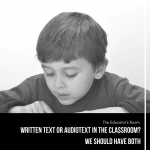An English as a second language student will need extra guidance and encouragement to write. Depending on the various stages of English acquisition in your classroom and the grade you teach depends on how you ask for a writing piece and what you can expect the student work to look like. These are some general guidelines to aid you in your classroom. There are many, many different ways to teach and ESL student but the one main objective you should keep in mind no matter what is to scaffold everything you do.
Beginning or Emergent Language Learners
These students are ones that walk in your door only days or weeks after arriving in the United States. If you are in a testing grade keep in mind that these students may be exempt or might be able to take a state test in their native language. Check with your ESL teacher to find out since every student is different. Keep in mind when teaching students at this level that they may be scared or even angry about being here. Use the beginning of your time with these students helping them acclimate to the new school environment. When doing a writing assignment with your class, you should try to make it as understandable as possible for everyone. Include the beginners in the lesson and the assignment. Drawing a picture is ok if it is connected to the topic. When conferencing with students, meet with your beginner and label the picture or write a simple sentence about the picture in English. You want them to understand how to say what they drew in English.
Intermediate Students
These students speak English, sometimes even fluently. It can be deceiving that they even belong in ESL. These students need extra support in writing. They also need writing to be meaningful to encourage them to write. Pen pals are a great encouragement in this situation. It is plainly evident to the student in this situation that their writing is meaningful and has a specific and tangible purpose. When doing pen pals, I love to keep their letters in a portfolio and show them at the end how much their writing has improved. It can be a great confidence booster.
Scaffolding and modeling goes a long way at this level of English acquisition. I also like to model and then go back over my model and diagram what was written. Remember, you can never scaffold too much. Language frames are a favorite of mine. I have seen students go from a low intermediate and pushed into an advanced level because of language frames (you might also know them as sentence starters). When writing a language frame, keep in mind the specific linguistic purpose you are trying to achieve in your lesson. Ask yourself, does past tense lend itself to this lesson? What about asking and answering questions? Etc. The language frames are not meant to be a crutch, they are meant to guide students on how to use a specific language function that is useful in a specific lesson.
Advanced Students
Advanced students can be very fun to teach. They are confident in their language abilities and just need to be pushed to the next level to move fully into the general education classroom. Idioms are a great writing topic to teach. Idiomatic phrases rarely, if ever, translate from language to language. At this level you are teaching the students to spice up their writing and make it more interesting and less formulaic; idioms are a great way to teach that. Language frames are also helpful at this level. Your focus for these frames have slightly shifted though. You are still focused on a language function, but now give the student an opportunity to create more complex sentences. Modeling is also something that is always useful.
Modeling and language frames are two tools in teaching writing to ESL students that are always useful. Graphic organizers are also a universal tool for all levels. Planning their writing will always make the task seem less daunting. When using any of these tools, please keep in mind to level them. I always have multiple language frames or graphic organizers for the same lesson. The student’s level depends on what they are given. Because of this, everything in my room is color coded. The students know what color they need and as the year progresses, I will change a student’s color depending on progress.
Teaching writing to ESL students can be a difficult and daunting task. If you take it step by step and realize what level of work you can expect from each individual student, it can and will be doable.






Leave a comment